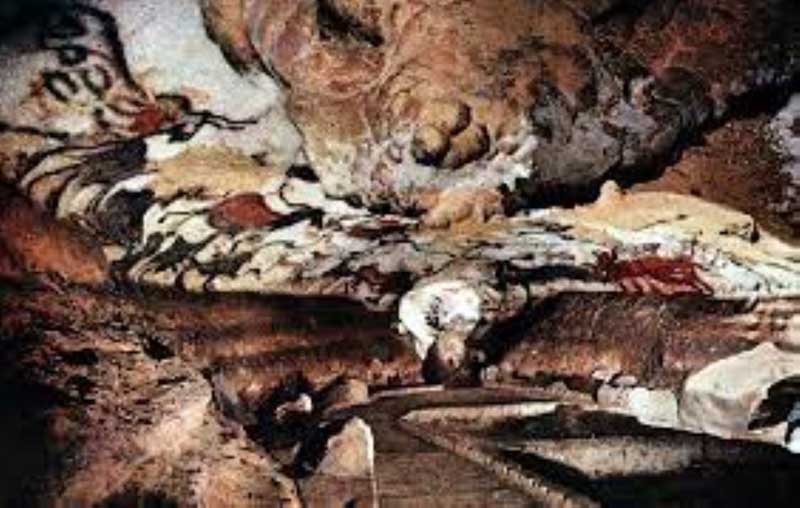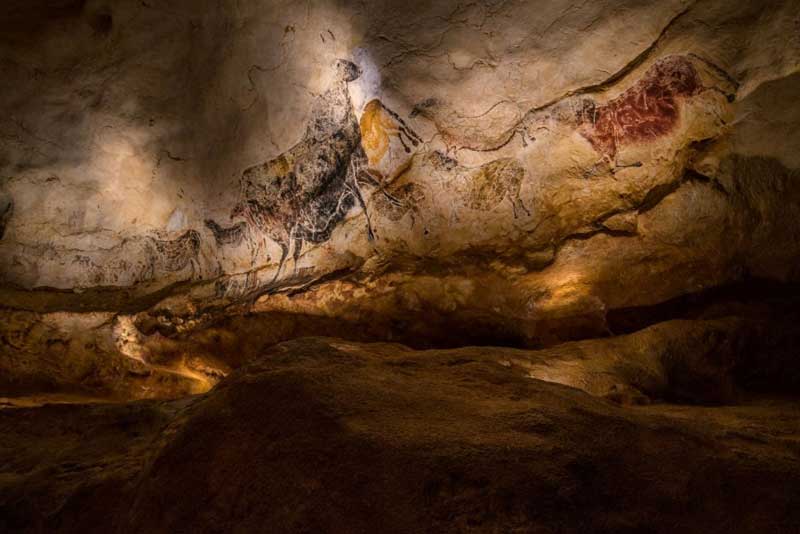
Lascaux Cave, a Palaeolithic cave situated in southwestern France, near the village of Montignac, houses some of the most famous examples of prehistoric cave paintings, estimated to be up to 20,000 years old, during the Upper Palaeolithic period. Besides the paintings of big animals like aurochs, horses, deer, bison and even some felines, which represent most of the major images, there are also around 1400 engravings of a similar order, created by the skilled hands of humans living in the area at that time. Since the discovery of the Lascaux Cave, several other beautifully decorated caves were also discovered in the region. This suggests that during the period, homo-sapiens or modern humans had been abundantly present in the region between southeastern France and the Cantabrian Mountains in the north of Spain, which includes Lascaux.
The Lascaux Cave consists of the main cavern, measuring around 66 feet (20 m) wide and 16 feet (5 m) high, along with several steep galleries, each of which is impressively decorated with painted, drawn and engraved figures. Apart from 600 painted and drawn animals and symbols, the cave also contains nearly 1500 engravings. It is evident that some sort of scaffolding was used by those ancient artists to reach the high walls and the ceiling of the cave.

The entrance to the Lascaux Cave was discovered accidentally by an 18-year-old boy Marcel Ravidat and his friends on12 September 1940, when Marcel’s dog had fallen in a fox hole on the hill of Lascaux. After widening the entrance, Marcel was the first one to slide down all the way to the bottom, followed by his friends. To their utter surprise, the teenagers discovered that the walls of the cave were covered with depictions of animals. The following day the boys entered the cave again to continue their adventure, equipped with a makeshift lamp and entered the cave through a 50 feet (15 m) deep shaft, which they believed to be a legendary secret passage to the nearby Lascaux Manor. This time, they explored deeper parts of the cave, decorated with depictions of animals and reported their findings to their teacher, Abbe Henri Breuil.

The process of exploring the cave was set into motion, when Abbe Henri Breuil and the boys returned to the spot on 21 September 1940, accompanied by Denis Peyrony curator of Les Eyzies Prehistory Museum in Les Eyzies, Archaeologist Jean Bouyssonie and Dr Cheynier. During the following month, an initial photographic campaign was carried out by Fernand Windels under the direction of Abbe Breuil and Maurice Thaon began to draw the figures. Breuil also spent considerable time in many of the caves, meticulously recording the images in drawings when the paintings were too challenging to photograph.
Finally, the cave was opened to the public on 14 July 1948, only to be closed in 1963 for the proper conservation and protection of the invaluable paintings. However, to overcome the problems of conservation, without depriving the public to admire the prehistoric masterpieces, replicas of the original paintings were created at the site, using the same type of materials like iron oxide, charcoal and ochre, which were believed to be used by the artists 20 thousand years ago.


It is evident that while working deep inside the cave, the ancient artists had to work in smoky conditions, as had to use stone lamps to suppress darkness, using animal
fat as fuel and painted using minerals as pigments for their images. While red, yellow and black colours were predominantly used, red was provided by the pigments of hematite or red clay, yellow from iron oxyhydroxides and black from charcoal or manganese oxides. The pigments were crushed and mixed with spit or animal fat, to be used with brushes made of hair procured from the tail of the animals or moss or by blowing directly onto the wall by hollow bones. Besides the paintings, many tools, even bone tools, were found at Lascaux, some of which display signs of being used specifically for carving engravings into the walls.

The galleries of the cave are named the Lateral Passage, the Shaft of the Dead Man, the Chamber of Engravings, the Painted Gallery and the Chamber of Felines While the famous Hall of Bulls is large enough to hold around fifty people, others are considerably narrow and tall. The entrance of the cave leads straight into the main chamber of the cave, the Hall of the Bulls, containing mostly aurochs, an extinct species of the bull family, used as cattle during the prehistoric age, along with several other animals like horses and deer who appear to be in flight. However, there are several other animals, which are not identifiable, such as the seemingly pregnant horse with what looks like one horn on its head. Beyond the Hall of the Bulls lies the Axial Gallery, a dead-end passage, dubbed the Sistine Chapel of Prehistory, as its ceiling is decorated with spectacular compositions.
The compositions comprise aurochs standing with their heads forming a circle, a mighty black bull on one side, a female aurochs on the other and horses in many shapes. A second exit from the Hall of the Bulls leads to the Passage, containing mostly engravings, while the Chamber of Felines throws some predators into the mix, with engravings of lions dominating the room.

Unfortunately, despite the closure, Lascaux has been beset with a fungus since 2000, variously blamed on the air conditioning system installed in the caves and the use of high-powered lights, although authorities have taken several actions to control the situation and protect the art. Nevertheless, considered a treasure trove of outstanding prehistoric art in the cave, Lascaux was inducted into the list of UNESCO World Heritage Sites in 1979.